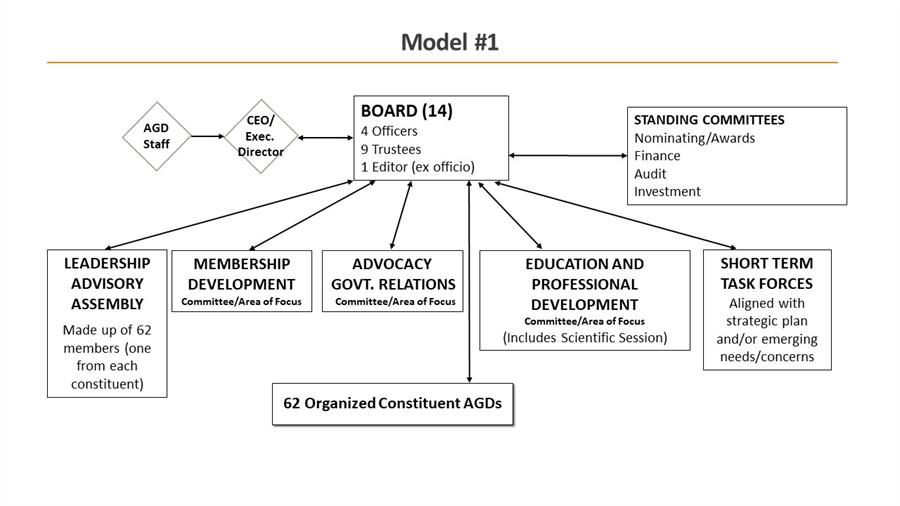Project Governance: Model #1
We are asking you to review and comment on the proposed governance models that have been developed through a series of meetings, interviews, surveys and planning workshops. Today we ask that you take a few minutes to review these models and describe the advantages and disadvantages of each model.
Model #1: The first model is designed for nimbleness. It provides a structure that allows the Board to respond promptly with well-equipped members to address emerging and existing issues. Task forces, Areas of Focus, and important committees will provide that leadership and ensure the organization is structured to be representative, collaborative, proactive, and responsive. It will create a strong Nominating Committee using a grid to determine geography, forms of practice, and demographics when recruiting people for leadership positions at AGD. The model recognizes the need for a "think tank" to advance AGD's mission, and a Leadership Advisory Assembly will discuss policies, issues impacting general dentistry from across the country, and critical research to bring to the Board so that the AGD can continue to advance in the direction of the interests of the membership. It also strives for diverse membership engagement with many on-ramps and utilizes task forces for maximum flexibility and respect for member time.
Design Intentions:
- Nimble
- Representative
- Collaborative
- Proactive/Responsive
- Flexible/Adaptive
- Develops the role of a Nominating Committee as vital to meeting several goals of the AGD
- Recognizes the need for a “think tank” to advance AGD’s mission
- Able to respond effectively and quickly to emerging issues
- Focused in areas central to AGD’s mission
- Strives for diverse membership engagement with many on-ramps
- Utilizes task forces for maximum flexibility and respect for member time

BODIES OF GOVERNANCE FOR MODEL #1
BOARD
Number:
14 members
Composition & Selection/Election:
- 4 Officers: President, President-Elect, Vice President, Treasurer (Treasurer is non-voting, Editor is ex officio).
Officers are one-year terms (excluding treasurer as a two-year term). President, President-Elect, and Vice President are in three-year succession rotation. Each year, Board elects Vice President. Only active members are eligible for officer roles.
- 9 Trustees: Three-year term. Not eligible for renomination. Trustees are not part of the Leadership Advisory Assembly.
Trustees nominated by each constituent, vetted by the Nominating Committee; slate presented to entire membership; unless a petition of 10% of members presents an alternative slate within 30 days, slate is approved. No constituent shall have more than one Board representative at a time.
Executive Director: Serves as Secretary (non-voting).
Responsibility:
- Budget
- Policy setting
- Vision
- Strategy
- Oversight
LEADERSHIP ADVISORY ASSEMBLY
Number:
Not to exceed 62 members
Composition & Selection/Election:
One member from each constituent.
Two-year terms, eligible for renomination once. Staggered terms. (Thus 31 constituencies are newly represented each year)
If a constituent does not nominate a representative, the Nominating Committee can recommend a student, retired, or other demographic categories to assure effective representation.
The Board approves the nominations for the Leadership Advisory Assembly.
Vice President serves as moderator/facilitator of the assembly.
Responsibility:
The Leadership Advisory Assembly is a think-tank to advise Board, including:
- Continuous environmental scanning
- Respond to particular questions of the board
One annual face-to-face meeting; three virtual quarterly meetings
COMMUNITIES/AREAS OF FOCUS
Number:
Sizes of committees are based on work to be done (ordinarily have no more than 10 members). The committees or task forces would be formed based on the issues and needs within the areas of focus.
Committees have two-year terms and focus on specific goals and areas of content
Standing committees are key operational committees supporting the Board of Directors.
Task Forces are for a limited time and focused on a limited purpose.
Composition & Selection/Election:
- Appointed by the Board, recommended by the Nominating Committee.
- Two-year terms; eligible for up to three terms.
- Committees can invite subject matter experts to participate. Each committee has a chair and chair-elect, rotation every two years. Chair-elect succeeds. Nominating Committee recommends each chair and chair-elect, appointed by the Board.
- All committee members (including chairs and chairs-elect) serve at the pleasure of the Board.
Responsibility:
Work toward outcomes stated in each committee charge. Align work with strategic plan. Achieve pre-determined goals.
NOMINATING COMMITTEE
Number:
9+ chair
Composition & Selection/Election:
- Chaired by the President-Elect (who is also the only Board member).
- Three-year staggered terms (1/3 rotates each year)
- Members recommended by the Leadership Advisory Assembly for Board approval.
Responsibility:
Present slate of candidates for all leadership positions (Board, committees); Leadership Advisory Assembly recommended by constituencies and vetted by nominations for appointment by the Board. Oversees leadership development programs/initiatives.
See grid wihich provides a comparision of the bodies of leadership associated with Model #1 who will support AGD and its work for all general dentists.
It's Time to Give Us Your Thoughts. Get Started Now!
Check for email (Subject line: AGD's New Governance Models Unveiled: Provide Input Now) to complete survey. Your feedback is crucial!
Town hall meetings will be held virtually for further explanations of thse models. Register here.
Please provide your feedback only once to ensure the accuracy of our data. Thank you for your participation.
